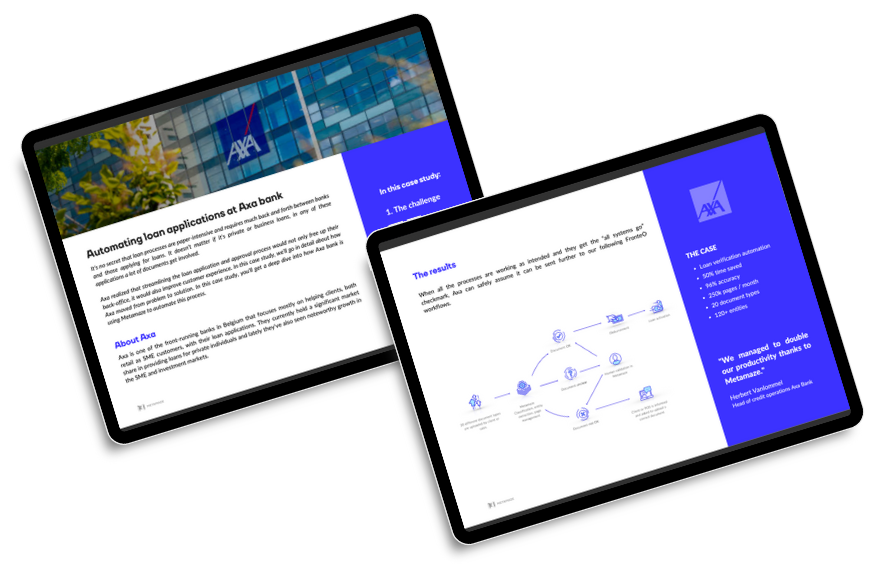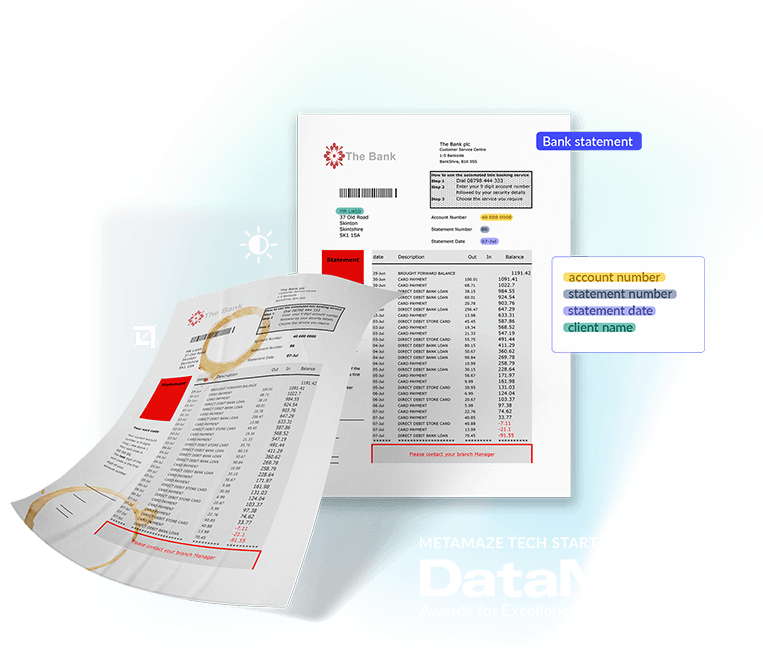Loan application automation at Axa
Discover how Axa bank was able to decrease loan application processing time with 50%.
Loan application processes are document-intensive. Axa realized that streamlining the loan application and approval process would not only free up their back-office, it would also improve customer experience.
In this case study, we’ll go in detail about how Axa moved from problem to solution.

Receive a more detailed pdf of this use case in your mailbox.
Tell us more about Axa bank.
"It is not our core activity to process huge amounts of paperwork, yet it takes up a weighty load of our time."
Bert Dirckx | Program Manager Axa Bank
How did Axa Bank go from a specific problem to your eventual Request For Proposal (RFP)?
There are two main motivating factors why we decided to launch an RFP. First, a rising need by our clients to be assisted more flexibly and more efficiently. Second, relieving our employees from non-value-adding manual work.
The market is very sensitive to trends, which means it fluctuates with ups and downs. For example, every year there is a clear peak in loan requests after “Batibouw”. Yet, one thing has remained consistent: the expectations of our clients have been evolving predictably.
"Our clients expect faster replies and assistance from us, even after office hours and during the weekends. Which perfectly understandable if you consider the following: when do our clients have time to discuss important matters such as loan applications? That's right: when they are at home and have time to do so. It so happens to be mostly during the evenings or weekends. So, we needed to make our process more efficient so we would have more time available to help our clients when they choose to reach out to us."
Bert Dirckx | Program Manager Axa Bank
We, therefore, wondered how we could handle the loan applications as efficiently as possible, without having to assign an army of employees each time there is a peak in loan requests from our clients.
One part of our workflow that takes up a significant amount of time is the checking and validation of a huge number of documents. Before we can issue out a loan, it is vital for both us and the client to establish a clear insight in the financials, and that naturally means verifying and validating official documents (such as salary slips, contracts, application forms, …). The necessity for document handling means that some of our expert employees had to perform tasks that were not particularly challenging for them, but they had to be performed, nonetheless.
We decided that we wanted to use the time and effort of our expert loan handling employees for value-adding activities, instead of manual work that was not enriching for them. In other words, there was a huge load of manual work ready to be automated.
To relieve our loan experts from non-value-adding activities, we needed to find a way to automate tasks that were hereto performed manually.
Herbert Vanlommel | Head of Credit Operations Axa Bank

Receive a more detailed pdf of this use case in your mailbox.
What were the most important requirements for your RFP that eventually led to Metamaze “winning” the case?
In the beginning, we were not focused on Artificial Intelligence (AI) at all. Initially, we thought that our “problem” could also be solved by Robotic Process Automation (RPA) or Optical Character Recognition (OCR) software. But we fairly quickly retracted this notion, because we noticed from our in-house innovation initiatives that there is a huge upside to integrating AI, and more specifically Machine Learning (ML).
For example: when working with good OCR technology, we still noticed a significant workload in identifying the specific location of certain “entities”/“fields” on the documents that needed to be processed, such as initials or signatures. Our people still needed to manually point the OCR machine to where it could retrieve the relevant information. So even though the documents themselves mostly look the same to the naked eye, sometimes the information that needed to be extracted was not always in the same location. We then noticed that even the best OCR technologies struggle with this thing that humans could normally easily spot. The Machine Learning (ML) of Metamaze on the other hand could automatically recognise where those entities were in the document, which was a game-changer for us. So, because not all information is always in the same place, Machine Learning saved us from this huge pain of having to constantly update template-based OCR solutions or manually intervene. In this regard, Metamaze was better than other big-name brands that offer OCR services.
Ultimately, our analysis defined the need for both OCR and ML which is why Metamaze beat the competition. I do have to note that other companies were sometimes better in one part or another of our requirements, but we found Metamaze to be the best fit for our needs as an end-to-end platform.
Why was Metamaze the perfect fit?
Apart from the unique combination of OCR and ML, the more specific reason why we chose Metamaze over other companies was the way you presented our case and how flexible you were in adjusting the software to our needs.
Once we had a Proof of Concept (POC), Metamaze made the difference by demonstrating how Machine Learning could save us time and effort by automatically recognising the entities of which we wanted to extract the data for further processing.
"The Metamaze platform hit all the checkmarks."
Bert Dirckx | Program manager Axa Bank
There is an entire process behind the document classification and data extraction from our loan application documents. The Metamaze process is able to classify documents, and extract data from it. But we’re also using business rules to verify if signatures are present or if the name on the document is the same as the applicant.
When all the processes are working as intended and they get the “all systems go” checkmark, we can safely assume it can be sent further to our following FronteO workflows.
Want to see the detailed process behind the Axa loan application workflow? We have put this together in a detailed pdf.

Receive the detailed Axa process in a pdf.
"To illustrate it with numbers: thanks to Metamaze, AXA manages to process the same amount of loan application documents with less than 50% of the time and effort.”
Bert Dirckx | Program manager Axa Bank
Would you recommend Metamaze to other colleagues looking to automate their document processing using AI?
Yes, it takes a certain amount of “change management” to make the switch to an Intelligent Document Processing platform. Yet in our case, I can definitely say that it is worth it.
If I may give some tips. Make sure to correctly scope your requirements. In our case, we were initially focused on the “automation” of the entire process. But we quickly learned that some parts that were automated didn’t bring us any benefits. This made us look back at our initial scope with a critical view and has taught us valuable lessons for the future: make sure to predefine the scope and clearly define all workflows beforehand.
Concretely: if you automate a certain task, but are not really “doing” anything with the extracted information during further processing steps, then why bother automating it? Why bother doing the task at all? This made us re-think our workflows and made us more efficient in the long run.
Is there one last thing you would like to add?
Key takeaways
Table of Contents
Request a Metamaze demo
Learn how Metamaze can help you automate any document and email in your organization. Book a demo with one of our experts and we’ll give you a quick tour of our product.


Metamaze is a no-code Intelligent Document Processing platform that uses AI to automate every document and email workflow.
Get Started
About

Metamaze is a no-code Intelligent Document Processing platform that uses AI to automate every document and email workflow.
